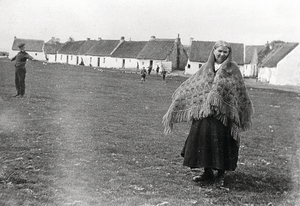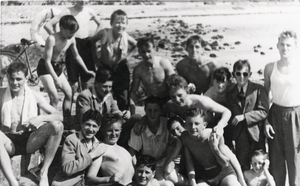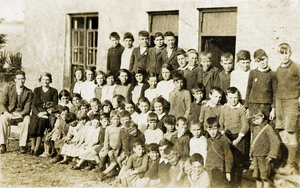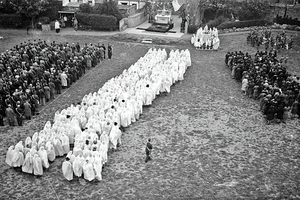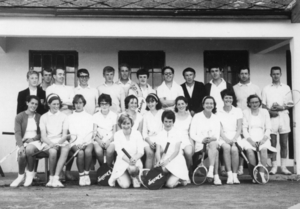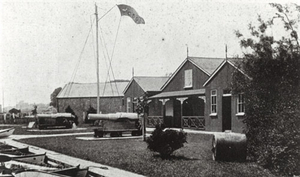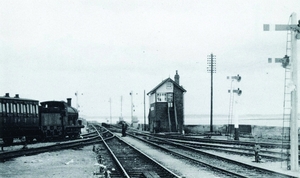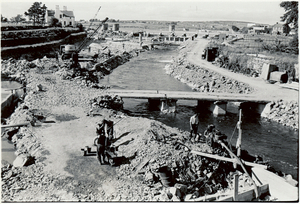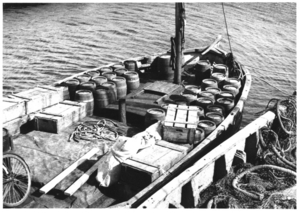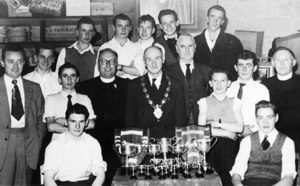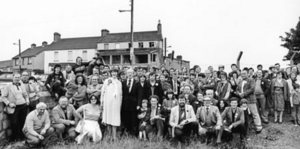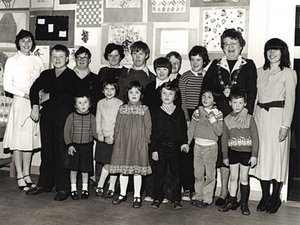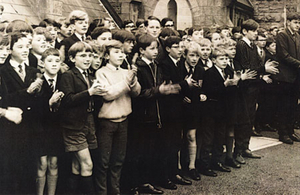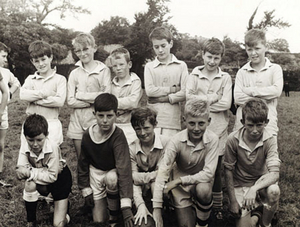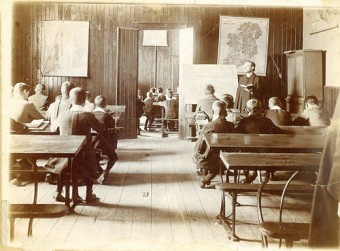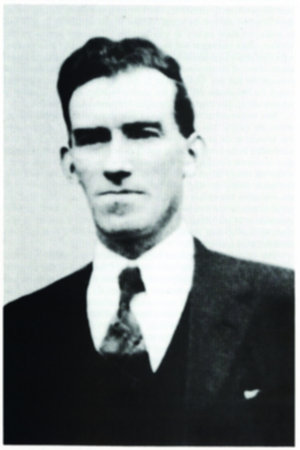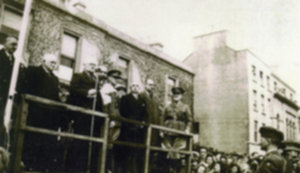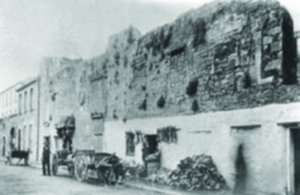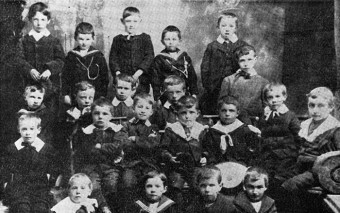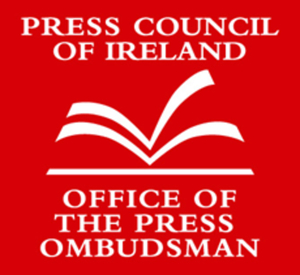The Gunna Mórs
Thu, Aug 21, 2014
This area of the Claddagh was known as ‘the Big Grass’ or ‘the Green Grass’. It was the one open space of ground in the village and faced what is known as the Swamp today. It was very marshy, though some of it was used as a playground by local children, and it was also where the Claddagh Races took place.
Read more ...Swimming in Salthill
Thu, Aug 14, 2014
Competitive swimming really began in Galway with the formation of two swimming clubs, Blackrock SC and Galway SC. Both were formed in 1930.
Read more ...Kiloughter long ago
Thu, Aug 07, 2014
This photograph of Carrabrowne National School was taken in 1936 and shows, back row, left to right: Pete Keane, Carrabrowne; Jimmy O’Brien, Kiloughter; Davey Corcoran, Carrabrowne; Willie Glynn, Kiloughter; Francis Corcoran, Carrabrowne; Stephen O’Brien, Carrabrowne; Mattie Casserley, Kiloughter; Willie Higgins, Ballindooley; Stephen O’Brien, Kiloughter; Mickey McGrath, Ballindooley; Tom Costelloe, Kiloughter; and Stephen Birmingham, Kiloughter.
Read more ...The Jesuit church
Thu, Jul 31, 2014
On this day, July 31, in 1863, “The new Church of St Ignatius on the Sea Road in the vicinity of the city was dedicated by the Most Rev Dr McEvilly, Lord Bishop of Galway. Sea Road is one of the most fashionable and frequented thoroughfares in the suburbs of our city. The Church, which was commenced in 1861, is now complete with the exception of the organ, altar and some minor internal decorations; and we have no doubt the zeal of the faithful will only require such a desirable opportunity of enabling the Jesuit Fathers, whose excellent judgement in these matters is fully acknowledged, to complete the required improvements, and that nothing shall be wanted which the good taste of the architect can suggest to make everything perfect. The Church is built of hammered limestone ashlar work in courses. The south gable, or principal front, the spire and the quoins, dressings etc, being finely punched and the depths of the jambs and arches of the principal doors and windows, which are richly moulded, adds greatly to its appearance. The Church, which is Gothic in style, is in the form of a Latin Cross, 115 feet in extreme length, 36 feet wide and 70 feet across the transepts, 56 to the ridge and 110 to the top of the spire”.
Read more ...The tennis club
Thu, Jul 24, 2014
The Galway Lawn Tennis and Croquet Club was founded at a meeting in the Royal Hotel, Eyre Square, on May 19, 1900. Many of the founders were members of the British army, the landed gentry, and the professions such as doctors, solicitors, professors, etc. Membership was by invitation only so there was a certain elitism attached to the club in the early days.
Read more ...The Corrib Club, one hundred and fifty years
Thu, Jul 17, 2014
The Corrib Club was founded in July 1864, 150 years ago this month. Unfortunately the minutes of the club for that year and 1865 are nowhere to be found, but the late Maurice Semple, having access to minutes for most other years, produced a book entitled A Century of Minutes, the Story of the Corrib Club 1864-1966, from which we publish extracts today.
Read more ...The Galway-Clifden Railway
Thu, Jul 10, 2014
This railway line was built under the auspices of the Congested Districts Board and was of enormous importance to the people of all of Connemara. It was a great feat of engineering from the point of departure westwards from Galway station with the necessary building of bridges and tunnels by Bohermore and across the Corrib itself.
Read more ...The Corrib Drainage Scheme
Thu, Jul 03, 2014
The waterways of the city are of great engineering significance. Two major projects resulted in the waterways system which exists today. The first scheme was constructed between 1848 and 1858. Its primary purpose was to improve drainage thus reducing winter water levels and the areas of flooded land and also navigation, without any detrimental effect on the mills or fishery interests. So the Eglinton canal was built, the Claddagh Basin, the dredging of the Corrib, Gaol and Western rivers, tailraces, culverts, the weir and salmon pass and Steamer’s Quay at Woodquay
Read more ...Traditional Galway boats
Thu, Jun 26, 2014
“With her brown barked sail, andher hull black tar,Her forest of oak ribs and thelarchwood planks,The cavern smelling hold bulkedwith costly gear,”
Read more ...The boys’ club
Thu, Jun 19, 2014
Our Lady’s Boys’ Club was founded in 1940 by Fr Leonard Shiel SJ. The main object of the club was “To provide for the relief of poverty by helping kids in need, by promoting human services which would meet long term means, and by those means to encourage their development and give their lives a dignity which is their birthright.”
Read more ...Michael D elected to the Dáil for the first time
Thu, May 29, 2014
In 1937 County Galway was divided into two constituencies for election purposes, and from then until 1977, when Galway West became a four-seater, this constituency always voted in two Fianna Fáil TDs and one Fine Gael. In 1977 we voted in Bobby Molloy, Bill Loughnane, and John Martin Mannion of Fine Gael.
Read more ...From humble beginnings to a digital school of distinction
Thu, May 22, 2014
In 1961, Seán Keane, a parent of a child with an intellectual disability, wrote a letter to the Connacht Tribune. He was looking for what all parents want for their children, a chance for them to achieve their full potential whether they be disabled or not. He got no response, so two months later he wrote again, this time a reply to his own letter. The National Association of Mentally Handicapped in Ireland had just been established, it saw the letter and it asked the local Irish National Teachers Organisation in the shape of Mick Raftery and Mícheál McSweeney to call a meeting.
Read more ...Bunscoil students in the Jes, 1963
Thu, May 15, 2014
In 1962, the Jesuit community in Sea Road celebrated the centenary of their school, and the following year they celebrated the centenary of the Church of St Ignatius. Eamon de Valera, who was president of Ireland at the time, attended the church celebrations, and our photograph today shows some of the students of the bunscoil applauding his arrival.
Read more ...The Devon park under-14 team, 1967
Thu, May 08, 2014
The great strength of the Gaelic Athletic Association is that it has spread into virtually every street and small village in the country. Having players and supporters all over Ireland has made this organisation one of the most popular and one of the most powerful in the land.
Read more ...Calling all Jes boys and girls
Thu, May 01, 2014
There is historical evidence to show that there were Jesuits working in Galway in the early 1600s. Even before that, men from the west of Ireland were entering the Jesuits which indicates that their reputation had arrived here very shortly after the Order was founded. They had a chequered history here (as they had in the rest of the country) in that they were banished several times, but they kept coming back.
Read more ...Eamonn Corbett and 1916
Thu, Apr 24, 2014
Eamonn Corbett came from Kileeneenbeg near Clarinbridge. He was associated with the Volunteer movement in County Galway from 1914 onwards. After the Redmondite split he gave valuable assistance in organising the Volunteers throughout the county, and in 1915 he was assisting Liam Mellows while training the various companies in the Brigade area.
Read more ...Constitution Day, April 18, 1949
Thu, Apr 17, 2014
On that day 65 years ago, the Government declared Ireland to be a Republic. This did not help Anglo-Irish relations at the time, and it also upset deValera and his Fianna Fáil colleagues, but it was the cause of public celebrations around the country.
Read more ...Market Street, one hundred years ago
Thu, Apr 10, 2014
The title of this photograph is ‘Old Building, Market Street’ and it was taken about 100 years ago. The building in the foreground was at one time occupied by the Augustinian nuns who were based in Galway (where the Mechanics is today in Middle Street) before 1651. The last Augustinian nun to die in Ireland is buried in Forthill. These sisters formed part of the same Augustinian Order as the friars, as do their contemplative successors today in countries like Spain and Italy. Continuing persecutions and other historical pressures saw to the end of these nuns in Ireland, though some lingered on in Galway up to the middle of the 19th century.
Read more ...Richardson’s pub, Eyre Square
Thu, Apr 03, 2014
The first reference to Eyre Square, or ‘The Green’ as it was then known, was in 1631 when it was planted with ash trees by Sir Valentine Blake. It was located outside the East Gate of the medieval city. “The square plot at the Green was set apart for the purpose of public amusement and recreation; it was enclosed with wooden rails and handsomely planted around.” The 1651 map of Galway features a row of small buildings which ran the length of the east side of the square.
Read more ...The Presentation Convent
Thu, Mar 27, 2014
One hundred and ninety five years ago this week, the Presentation Sisters opened their convent on Presentation Road, on March 25 1819 to be precise. Some years before that, Doctor ffrench, the warden of Galway, went to Kilkenny to ask the sisters there if they could found a convent here. He had a fund for the purpose, and so, on October 27 1815, three sisters arrived to a house in Kirwan’s Lane. This building was not large enough for them and the 30 girls of the school which had been handed over to them by a committee of ladies, so they moved into a larger house on Eyre Square where they remained for three years.
Read more ...